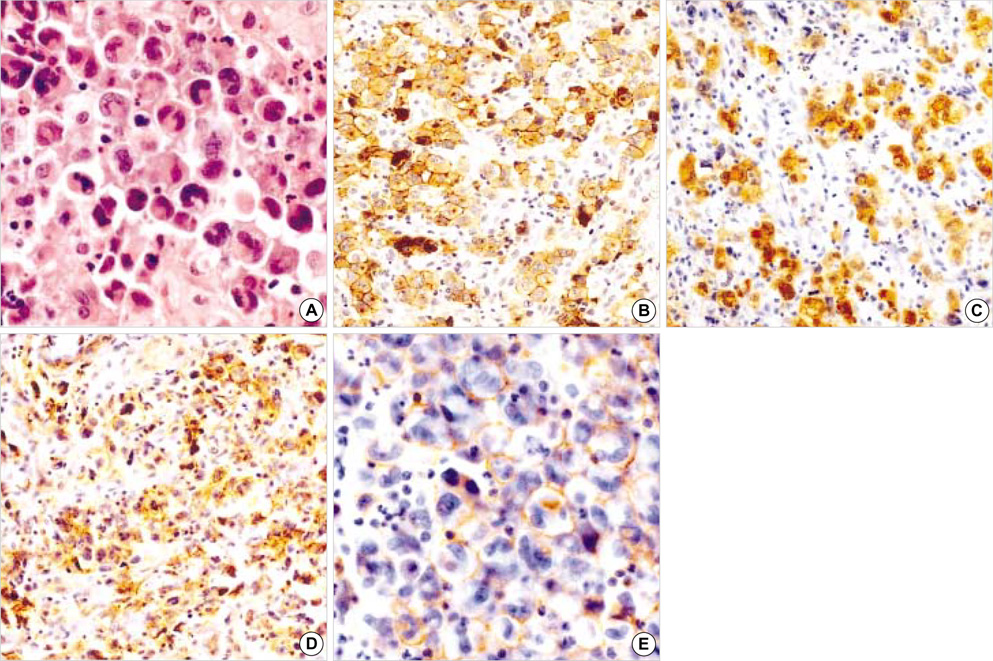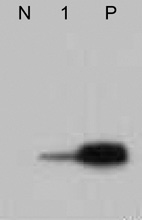J Korean Med Sci.
2005 Dec;20(6):952-956. 10.3346/jkms.2005.20.6.952.
Immunoreactivity of CD99 in Non-Hodgkin's Lymphoma: Unexpected Frequent Expression in ALK-positive Anaplastic Large Cell Lymphoma
- Affiliations
-
- 1Department of Pathology, Samsung Medical Center, Sungkyunkwan University School of Medicine, Seoul, Korea. yhko@smc.samsung.co.kr
- 2Department of Hematooncology, Samsung Medical Center, Sungkyunkwan University School of Medicine, Seoul, Korea.
- KMID: 2157743
- DOI: http://doi.org/10.3346/jkms.2005.20.6.952
Abstract
- To verify the spectrum of CD99-expressing lymphoid malignancy, an immunohistochemical study for CD99 was carried out in 182 cases of non-Hodgkin's lymphoma, including 21 lymphoblastic lymphomas, 11 small lymphocytic lymphomas, 9 mantle cell lymphomas, 12 follicular lymphomas, 37 diffuse large B cell lymphomas, 18 Burkitt's lymphomas, 28 NK/T-cell lymphomas, 8 angioimmunoblastic T-cell lymphomas, 23 peripheral T-cell lymphomas, unspecified, and 15 systemic anaplastic large cell lymphomas. CD99 was positive in all T-lymphoblastic lymphomas and in 60% of B-lymphoblastic lymphomas. Majority of T and NK cell lymphomas were negative for CD99, except anaplastic large cell lymphomas (ALCLs). Eight of 15 cases (54%) of ALCLs reacted with anti CD99 antibody. Seven of 10 (70%) ALK positive ALCLs expressed CD99, whereas only 1 of 5 (20%) ALK negative ALCLs were positive. Of the mature B-cell lymphomas, 5.4% (2/37) of diffuse large B cell lymphomas and 11.1% (2/18) of Burkitt's lymphomas expressed CD99. In conclusion, CD99 is infrequently expressed in mature B and T cell lymphomas, except ALK-positive ALCL. High expression of CD99 in ALK-positive ALCL is unexpected finding and its biologic and clinical significances have yet to be clarified.
MeSH Terms
Figure
Reference
-
1. Hahn JH, Kim MK, Choi EY, Kim SH, Sohn HW, Ham DI, Chung DH, Kim TJ, Lee WJ, Park CK, Ree HJ, Park SH. CD99 (MIC2) regulates the LFA-1/ICAM-1-mediated adhesion of lymphocytes, and its gene encodes both positive and negative regulators of cellular adhesion. J Immunol. 1997. 159:2250–2258.2. Waclavicek M, Majdic O, Stulnig T, Berger M, Sunder-Plassmann R, Zlabinger GJ, Baumruker T, Stockl J, Ebner C, Knapp W, Pickl WF. CD99 engagement on human peripheral blood T cells results in TCR/CD3-dependent cellular activation and allows for Th1-restricted cytokine production. J Immunol. 1998. 161:4671–4678.3. Hamilton G, Fellinger EJ, Schratter I, Fritsch A. Characterization of a human endocrine tissue and tumor-associated Ewing's sarcoma antigen. Cancer Res. 1988. 48:6127–6131.4. Weidner N, Tjoe J. Immunohistochemical profile of monoclonal antibody O13: antibody that recognizes glycoprotein p30/32MIC2 and is useful in diagnosing Ewing's sarcoma and peripheral neuroepithelioma. Am J Surg Pathol. 1994. 18:486–494.5. Ramani P, Rampling D, Link M. Immunocytochemical study of 12E7 in small round-cell tumours of childhood: an assessment of its sensitivity and specificity. Histopathology. 1993. 23:557–561.
Article6. Pelosi G, Fraggetta F, Sonzogni A, Fazio N, Cavallon A, Viale G. CD99 immunoreactivity in gastrointestinal and pulmonary neuroendocrine tumours. Virchows Arch. 2000. 437:270–274.
Article7. Gordon MD, Corless C, Renshaw AA, Beckstead J. CD99, keratin, and vimentin staining of sex cord-stromal tumors, normal ovary, and testis. Mod Pathol. 1998. 11:769–773.8. Granter SR, Renshaw AA, Fletcher CD, Bhan AK, Rosenberg AE. CD99 reactivity in mesenchymal chondrosarcoma. Hum Pathol. 1996. 27:1273–1276.
Article9. Jung KC, Park WS, Bae YM, Hahn JH, Hahn K, Lee H, Lee HW, Koo HJ, Shin HJ, Shin HS, Park YE, Park SH. Immunoreactivity of CD99 in stomach cancer. J Korean Med Sci. 2002. 17:483–489.
Article10. Yoo SH, Han J, Kim TJ, Chung DH. Expression of CD99 in pleomorphic carcinomas of the lung. J Korean Med Sci. 2005. 20:50–55.
Article11. Robertson PB, Neiman RS, Worapongpaiboon S, John K, Orazi A. 013 (CD99) positive in hematologic proliferations correlates with TdT positivity. Mod Pathol. 1997. 10:277–282.12. Zhang PJ, Barcos M, Stewart CC, Block AW, Sait S, Brooks JJ. Immunoreactivity of MIC2 (CD99) in acute myelogenous leukemia and related diseases. Mod Pathol. 2000. 13:452–458.
Article13. Riopel M, Dickman PS, Link MP, Perlman EJ. MIC2 analysis in pediatric lymphomas and leukemias. Hum Pathol. 1994. 25:396–399.
Article14. Vartanian RK, Sudilovsky D, Weidner N. Immunostaining of monoclonal antibody 013 [anti-MIC2 gene product (CD99)] in lymphomas; impact of heat-induced epitope retrieval. Appl Immunohistochem. 1996. 4:43–55.15. Jaffe ES, Harris NL, Stein H, Vardiman J, editors. World Health Organization Classification of Tumors. Pathology & Genetics. Tumors of Hematopoietic and Lymphoid Tissues. 2001. Lyon: IARC Press.16. Dworzak MN, Fritsch G, Buchinger P, Fleischer C, Printz D, Zellner A, Schollhammer A, Steiner G, Ambros PF, Gadner H. Flow cytometric assessment of human MIC2 expression in bone marrow, thymus, and peripheral blood. Blood. 1994. 83:415–425.
Article17. Dworzak MN, Fritsch G, Fleischer C, Printz D, Froschl G, Buchinger P, Mann G, Gadner H. CD99 (MIC2) expression in paediatric B-lineage leukaemia/lymphoma reflects maturation-associated patterns of normal B-lymphopoiesis. Br J Haematol. 1999. 105:690–695.
Article18. Stein H, Herbst H, Anagnostopoulos I, Niedobitek G, Dallenbach F, Kratzsch HC. The nature of Hodgkin and Reed-Sternberg cells, their association with EBV, and their relationship to anaplastic large-cell lymphoma. Ann Oncol. 1991. Suppl 2. 33–38.
Article19. Leoncini L, Del Vecchio MT, Kraft R, Megha T, Barbini P, Cevenini G, Poggi S, Pileri S, Tosi P, Cottier H. Hodgkin's disease and CD30-positive anaplastic large cell lymphomas-a continuous spectrum of malignant disorders. A quantitative morphometric and immunohistologic study. Am J Pathol. 1990. 137:1047–1057.20. Lee IS, Shin YK, Chung DH, Park SH. LMP1-induced down-regulation of CD99 molecules in Hodgkin and Reed-Sternberg cells. Leuk Lymphoma. 2001. 42:587–594.
Article21. Bargou RC, Leng C, Krappmann D, Emmerich F, Mapara MY, Bommert K, Royer HD, Scheidereit C, Dorken B. High-level nuclear NF-kappa B and Oct-2 is a common feature of cultured Hodgkin/Reed-Sternberg cells. Blood. 1996. 87:4340–4347.
Article22. Horie R, Watanabe M, Ishida T, Koiwa T, Aizawa S, Itoh K, Higashihara M, Kadin ME, Watanabe T. The NPM-ALK oncoprotein abrogates CD30 signaling and constitutive NF-kappaB activation in anaplastic large cell lymphoma. Cancer Cell. 2004. 5:353–364.23. Jung KC, Kim NH, Park WS, Park SH, Bae Y. The CD99 signal enhances Fas-mediated apoptosis in the human leukemic cell line, Jurkat. FEBS Lett. 2003. 554:478–484.
Article24. Cerisano V, Aalto Y, Perdichizzi S, Bernard G, Manara MC, Benini S, Cenacchi G, Preda P, Lattanzi G, Nagy B, Knuutila S, Colombo MP, Bernard A, Picci P, Scotlandi K. Molecular mechanisms of CD99-induced caspase-independent cell death and cell-cell adhesion in Ewing's sarcoma cells: actin and zyxin as key intracellular mediators. Oncogene. 2004. 23:5664–5674.
Article25. ten Berge RL, Meijer CJ, Dukers DF, Kummer JA, Bladergroen BA, Vos W, Hack CE, Ossenkoppele GJ, Oudejans JJ. Expression levels of apoptosis-related proteins predict clinical outcome in anaplastic large cell lymphoma. Blood. 2002. 99:4540–4546.
Article26. Rassidakis GZ, Sarris AH, Herling M, Ford RJ, Cabanillas F, McDonnell TJ, Medeiros LJ. Differential expression of BCL-2 family proteins in ALK-positive and ALK-negative anaplastic large cell lymphoma of T/null-cell lineage. Am J Pathol. 2001. 159:527–535.
Article
- Full Text Links
- Actions
-
Cited
- CITED
-
- Close
- Share
- Similar articles
-
- A Case of CD30 (+)/ALK (-) Systemic Anaplastic Large Cell Lymphoma
- CD30-Positive Anaplastic Lymphoma Kinase-Negative Systemic Anaplastic Large-Cell Lymphoma in a 9-Year-Old Boy
- A Case of ALK-Negative Systemic Anaplastic Large Cell Lymphoma
- A Case of CD30 (+)/ALK (-) Primary Systemic AnaplasticLarge Cell Lymphoma with Atypical Clinical Features
- A Case of CD 30+/ALK− Primary Systemic Anaplastic Large Cell Lymphoma Presenting a Sporotrichoid Pattern



